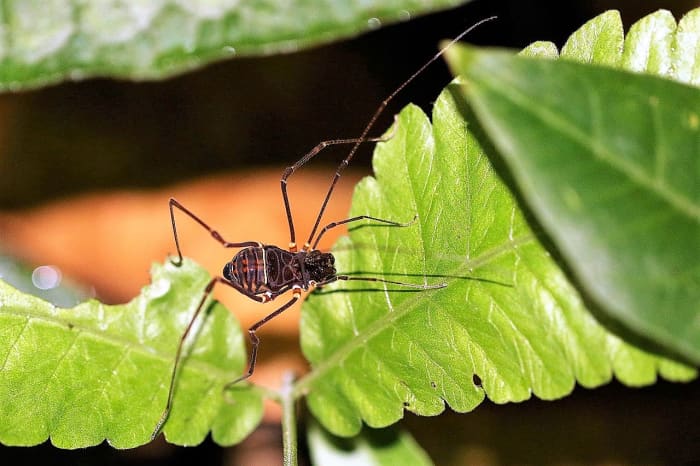42 Interesting Facts About Harvestmen or Daddy Longlegs
Interesting Arachnids
Harvestmen are interesting arachnids. They are known for their long and spindly legs that make them look as though they're walking on stilts. Some people confuse them with spiders, which are also arachnids, but the two creatures are actually quite different animals. Despite rumors to the contrary, harvestmen are not dangerous to humans. They are intriguing creatures with some unusual features.
Harvestmen belong to the phylum Arthropoda, the class Arachnida, and the order Opiliones. They are also known as daddy longlegs or as granddaddy longlegs. Somewhat confusingly, cellar spiders and crane flies may also be referred to as daddy longlegs.
The table below summarizes the relationship between harvestmen, spiders, and insects. Spiders belong to the same phylum and class as harvestmen, but they belong to the order Araneae instead of the order Opiliones. Insects also belong to the phylum Arthropoda, but they don't belong to the class Arachnida and therefore aren't known as arachnids.
Arachnid and Insect Classification
| Animals | Phylum | Class | Order |
|---|---|---|---|
Harvestmen | Arthropoda | Arachnida | Opiliones |
Spiders | Arthropoda | Arachnida | Araneae |
Insects | Arthropoda | Insecta | Various |

Santinezia serratotibialis, a harvestman in Trinidad
Charles J Sharp, via Wikimedia Commons. CC BY-SA 4.0 license
The order name Opiliones comes from the Latin word opilio, which means shepherd. Harvestmen reminded earlier people of European shepherds who walked on stilts to get a good view of their flock. The animals are sometimes referred to as shepherd spiders, though as explained above, they aren't spiders.
Differences Between Harvestmen and Spiders
1. The body of a spider is composed of two sections that often look different from one another. The cephalothorax or prosoma is joined to the abdomen or opisthosoma by a narrow stalk, though the stalk may not be visible when a spider is seen.
2. The harvestman also has a cephalothorax and an abdomen. The union between them is not obvious, however, and they look the same. The body appears to consist of just one section.
3. A spider has three or four pairs of eyes, which are generally positioned at the front edge of the cephalothorax. A harvestman has only one pair of eyes, which are located on the top of the cephalothorax.
4. Most harvestmen have very long and spindly legs, but this isn't a foolproof way to identify them. Some have shorter and thicker legs. In addition, some spiders have long legs, though they aren't as long or as thin as those of a typical harvestman.
5. An urban legend says that harvestmen are the most venomous animals (or spiders) in the world. The reality is completely different. Unlike spiders, harvestmen don't have venom glands. In addition, the mouth and jaws, or chelicerae, are too small to do us much harm.
6. Harvestmen don't have silk glands and don't create a web. They do have glands that make a smelly secretion, though.
7. Harvestmen eat solid pieces of food. Spiders release digestive enzymes into their food and then ingest the liquid material.
8. The body of a typical harvestman is very small in comparison to the legs. The body is often no more than half an inch in length and is usually smaller.
The bunny harvestman of Ecuador has attracted people's attention due to its "rabbit ears". The animal's body reminds people of a dog's head as well as a rabbit. Two yellow spots on the body look like eyes, though they aren't the arachnid's actual eyes. The animal's appearance may be designed to scare predators.
Range and Habitat of the Order Opiliones
9. Around 6,500 species of harvestmen are known. Some scientists believe that there are likely many more in existence. The animals are found on every continent except Antarctica.
10. The greatest variety of daddy longlegs is found in tropical areas. Though most of the animals have dull colors, some have green, yellow, and/or red markings, especially in the tropics.
11. The animals are often found in humid places, such as in leaf litter, crevices, caves and under rocks and tree bark.
12. According to the University of Kentucky, harvestmen are sometimes seen in the basements of houses. They may also be found in crawl spaces and in sheds and barns.
13. The name "harvestman" is derived from the fact that the animals are most often seen in late summer and early fall during the harvest season. They are visible during this season because it's generally the time when they mate.




The order Opiliones contains five suborders. Harvestmen are not widely studied. It's possible that some of the observed behaviors occur only in members of certain suborders.
Daily Life of a Harvestman
14. Harvestmen are often nocturnal, but some are partially or completely diurnal (active during the day). They dehydrate easily, so they often hunt briefly during the day and then go into hiding for a while.
15. The animals are omnivorous. They eat insects, spiders, mites, an occasional snail, and plant material. They are predators and possibly scavengers as well.
16. The pedipalps are short appendages that pick up food, manipulate it, and pass it to the mouth. They are located in front of the jaws, or chelicerae.
17. Researchers have discovered that in at least some harvestmen, the tips of the pedipalps (or "feelers") have hairs that secrete a type of glue. This helps them to grab food.
18. The eyes of a daddy longlegs can detect the intensity of light, but the animals can't see images. They need the help of other senses to find their prey.
19. The animals have four pairs of legs, like a spider. The tips of the legs have multiple joints. They are covered with fine hairs and have a hook at the end.
20. The second pair of legs have sense organs and are used for probing the environment. They can detect vibrations and possibly certain chemicals. While many sources classify the second pair of legs as sensory appendages, a few say that the first pair of legs are more important for sensing the environment, at least in some suborders.



